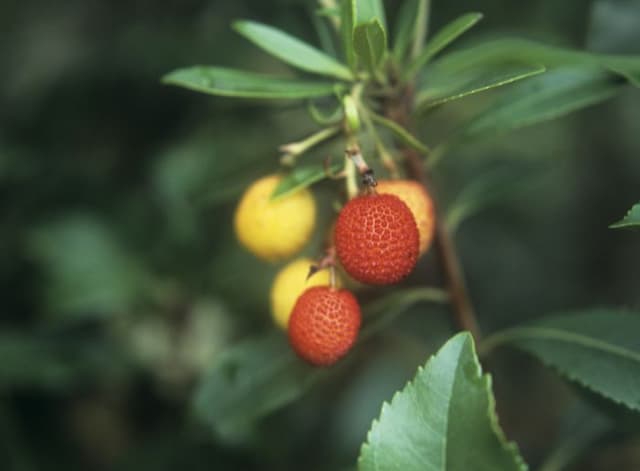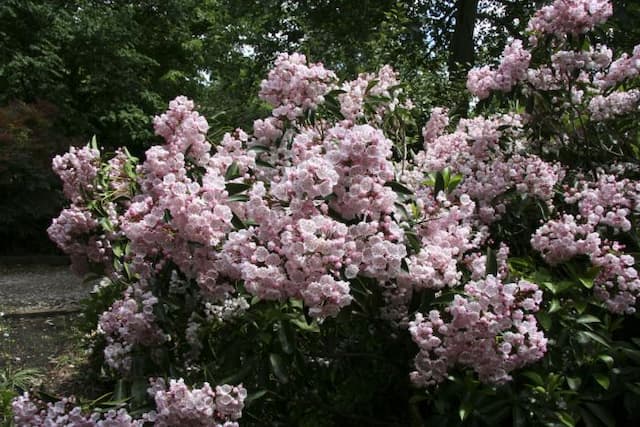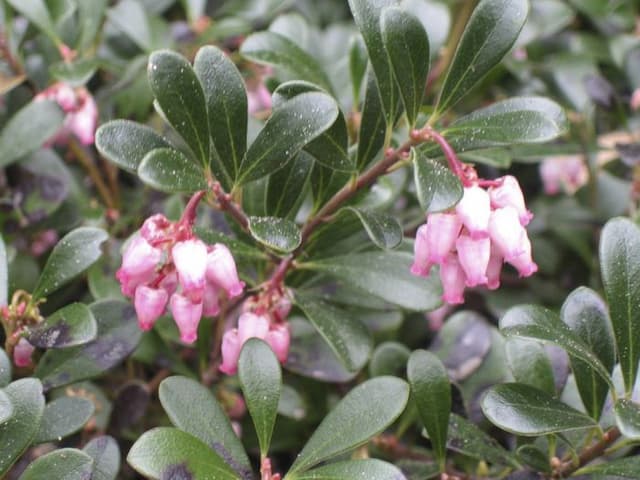Ozark Blue Huckleberry Vaccinium 'Ozarkblue' (F)

ABOUT
'Ozarkblue' is a variety of blueberry that showcases an attractive habit with dense, green foliage. The leaves are oval-shaped and have a smooth texture with a slight sheen on the surface, contributing to a lush appearance throughout the growing season. Come spring, the plant is adorned with small, bell-shaped flowers that exhibit a delicate white or pale pink color, which adds a subtle floral display to the garden. As the season progresses, the flowers give way to the plant’s most celebrated feature – its berries. The blueberries are plump, with a rich blue to purple hue and a protective, powdery bloom on the skin. They are usually gathered in small clusters, which makes harvesting easier and adds visual interest to the plant. During the fall, foliage can undergo a transformation with leaves that may develop striking red and purple tones, offering a pleasant contrast to the waning days of the growing season. Even with the berries gone, the autumnal display of the 'Ozarkblue' blueberry provides a compelling reason to appreciate the plant as it prepares for the dormant winter months.
About this plant
 Names
NamesFamily
Ericaceae
Synonyms
Ozarkblue Blueberry, Northern Highbush Blueberry
Common names
Vaccinium 'Ozarkblue'
 Toxicity
ToxicityTo humans
Ozarkblue blueberry is generally regarded as non-toxic to humans and is widely consumed for its edible fruits. There is no significant evidence suggesting that usual consumption of the berries, leaves, or any parts of the Ozarkblue blueberry plant leads to poisoning in humans. As with any plant, individuals may have specific allergies or sensitivities, and it is always advisable to consume only known and properly identified edible parts.
To pets
Ozarkblue blueberry is also generally considered non-toxic to pets, including dogs and cats. The fruit of the Ozarkblue blueberry plant is safe for pets to eat in moderation. There is no commonly reported toxicity from pets ingesting the berries, leaves, or other parts of the plant. However, as with humans, individual pets can have allergies or sensitivities, and it is always best to introduce any new food to a pet's diet in small amounts and observe for any adverse reactions.
 Characteristics
CharacteristicsLife cycle
Perennials
Foliage type
Deciduous
Color of leaves
Green
Flower color
White
Height
4-6 feet (1.2-1.8 meters)
Spread
3-5 feet (0.9-1.5 meters)
Plant type
Shrub
Hardiness zones
5
Native area
North America
Benefits
 General Benefits
General Benefits- Edible Fruits: Produces delicious blueberries that are useful in various culinary dishes and beverages.
- Attractive Ornamental: Features attractive foliage and flowers that enhance garden aesthetics.
- Wildlife Attraction: The flowers and fruits attract bees, birds, and butterflies, supporting local ecosystems.
- Hardy Growth: Adapts well to a variety of soil conditions and can withstand cold temperatures.
- Easy Maintenance: Requires minimal care once established, making it suitable for novice gardeners.
- Long Fruit Bearing Season: Offers an extended harvesting period compared to some other blueberry varieties.
- High Yield: Known for producing abundant fruit, providing a plentiful supply for home use.
- Erosion Control: The root system can help stabilize soil and prevent erosion in certain environments.
 Medical Properties
Medical PropertiesThis plant is not used for medical purposes.
 Air-purifying Qualities
Air-purifying QualitiesThis plant is not specifically known for air purifying qualities.
 Other Uses
Other Uses- Dye Production: The berries of the Ozarkblue blueberry can be used to make natural dyes for fabrics or crafts, providing a range of blue and purple hues.
- Ink Making: Similar to dyes, the juice from the Ozarkblue blueberry can be used to create homemade inks for writing or drawing.
- Wildlife Habitat: When planted in gardens or natural areas, Ozarkblue blueberry bushes can provide shelter and food for birds and other wildlife.
- Photography Subject: The attractive clusters of berries and flowers make Ozarkblue blueberry plants popular subjects for photographers and artists.
- Educational Tool: These plants can be used in educational settings to teach about plant biology, pollination, and fruit development.
- Soil Erosion Control: The rooting system of Ozarkblue blueberry bushes can help to stabilize soil and prevent erosion, particularly on slopes.
- Craft Materials: Twigs and branches from the plant can be used in rustic craft projects or as natural supports for other plants in the garden.
- Landscape Design: With their attractive foliage and form, these blueberry bushes can be incorporated into landscape designs as ornamental features.
- Natural Fencing: When planted in rows or hedges, Ozarkblue blueberry bushes can serve as a natural, living fence that also provides fruit.
- Seasonal Decor: In autumn, the leaves turn vibrant colors; they can be used for seasonal decorations or added to autumn wreaths.
Interesting Facts
 Feng Shui
Feng ShuiThe Blueberry is not used in Feng Shui practice.
 Zodiac Sign Compitability
Zodiac Sign CompitabilityThe Blueberry is not used in astrology practice.
 Plant Symbolism
Plant Symbolism- Abundance: The blueberry (common name of 'Ozarkblue') is a fruit-bearing plant, commonly symbolizing abundance and fertility due to its plentiful fruit.
- Protection: In folklore, blueberries were thought to ward off evil spirits; thus they represent protection.
- Gratitude: The blueberry's generous production of fruit can symbolize a sense of thankfulness and appreciation.
- Longevity: Blueberry plants are perennial and can live for many years, symbolizing long life and endurance.
- Good Health: As blueberries are rich in antioxidants and vitamins, they've become a symbol of good health and well-being.
 Water
WaterFor the 'Ozarkblue' blueberry, it is essential to maintain moist soil, especially during the growing and fruiting seasons. Irrigate the plant with about 1 to 2 gallons of water per week, adjusting for rainfall and climate conditions. During the hotter, dryer periods, this may increase to twice a week. It is crucial to avoid waterlogging by ensuring good soil drainage, so the roots do not sit in overly saturated soil. A drip irrigation system is ideal for providing consistent and even moisture directly to the root zone.
 Light
Light'Ozarkblue' blueberries thrive best in full sunlight, receiving at least 6 to 8 hours of direct sunlight daily. The ideal spot would be in an area with unobstructed exposure to the sun, as this ensures adequate light for maximum fruit production and healthy plant growth. Partial shade is acceptable but may result in fewer berries and less vigorous growth.
 Temperature
Temperature'Ozarkblue' blueberry plants prefer moderate temperatures and can tolerate minimum winter temperatures down to about 0 degrees Fahrenheit. Optimal growth occurs when daytime temperatures are between 60 and 75 degrees Fahrenheit. They can survive up to a max temperature of around 85 to 90 degrees Fahrenheit, but prolonged exposure to extreme heat may stress the plants.
 Pruning
PruningPruning 'Ozarkblue' blueberries is essential to maintain plant health and to increase fruit production. Prune plants in late winter to early spring before new growth begins, removing any dead or diseased wood, thinning out crowded branches and cutting back some of the oldest canes each year. This allows better air circulation, sunlight penetration, and encourages new growth that is more fruitful.
 Cleaning
CleaningAs needed
 Soil
SoilThe best soil mix for Ozarkblue Blueberry should be well-draining with high organic matter content. A mix with equal parts peat moss, pine bark, and loamy soil is ideal. The soil pH should be acidic, ranging between 4.5 and 5.5 for optimal growth and berry production.
 Repotting
RepottingOzarkblue Blueberries should be repotted every 2 to 3 years to refresh the soil and accommodate root growth. It's best to repot in the late winter or early spring before new growth begins.
 Humidity & Misting
Humidity & MistingOzarkblue Blueberry thrives in moderate to high humidity levels. Aim to maintain a humidity level of around 50-60% for the best growth. Protecting plants from dry, windy conditions will help sustain appropriate humidity levels.
 Suitable locations
Suitable locationsIndoor
Ensure acidic soil, bright light, and regular watering for indoor growth.
Outdoor
Plant in acidic soil, full sun to part shade, mulch well.
Hardiness zone
5-8 USDA
 Life cycle
Life cycleThe Ozark Blue Blueberry (Vaccinium 'Ozarkblue') begins its life cycle when a mature plant's flowers are pollinated, usually by bees, leading to the development of berry-like fruit containing seeds. After seed dispersal, germination can occur under favorable conditions of moisture and temperature, with seedlings emerging to start new plants. Blueberry seedlings grow gradually, developing a root system and foliage over the first few years, and typically reach fruit-bearing maturity at around 6 to 8 years of age. Each year, mature Ozark Blue Blueberry plants undergo a cycle of growth that starts with bud break in the spring, followed by leafing out, flowering, and fruit set. During the summer, the fruits ripen and are harvested, with the plant subsequently entering a period of dormancy during the winter to conserve energy. The plant's life span can extend for many years, with the bushes continuing to produce fruit annually if they are well-maintained through proper pruning, watering, and fertilization.
 Propogation
PropogationPropogation time
Spring-Early Summer
One of the most popular methods for propagating the Ozark Blue blueberry is through softwood cuttings. This process typically occurs in late spring or early summer when the plant's new growth is still tender and flexible. Cuttings should be taken from healthy, disease-free shoots that are about 4 to 6 inches long. The lower leaves are removed, and the cut end is often treated with a rooting hormone before being placed in a moist, soilless growing medium. The environment should have high humidity and the cuttings should be kept out of direct sunlight. Roots usually develop within several weeks, and once they're well-established, the new plants can be transferred to individual pots and eventually to their permanent location outdoors.









